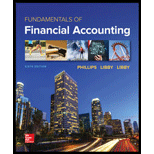
Loose Leaf For Fundamentals Of Financial Accounting
6th Edition
ISBN: 9781260159547
Author: Phillips Associate Professor, Fred, Libby, Robert, Patricia
Publisher: McGraw-Hill Education
expand_more
expand_more
format_list_bulleted
Question
Chapter 13, Problem 6MC
To determine
Explain the company that has least likely to experience problems in paying its current liabilities
Expert Solution & Answer
Want to see the full answer?
Check out a sample textbook solution
Students have asked these similar questions
Accounting problem
A firm has a total debt ratio of 50%, total debt of $500,000, and
net income of $65,000. What is the firm's return on equity
(ROE)?
a) 12.50%
b) 15.80%
c) 13.00%
d) 14.75%
A company failed to record unrealized gains of $25 million on its available-for-sale
security investments. Its tax rate is 40%. As a result of this error, comprehensive
income would be (Round million answer to 2 decimal places.):
Chapter 13 Solutions
Loose Leaf For Fundamentals Of Financial Accounting
Ch. 13 - What is the general goal of trend analysis?Ch. 13 - Prob. 2QCh. 13 - What is ratio analysis? Why is it useful?Ch. 13 - What benchmarks are commonly used for interpreting...Ch. 13 - Prob. 5QCh. 13 - Prob. 6QCh. 13 - Slow Cellars current ratio increased from 1.2 to...Ch. 13 - From last year to this year, Colossal Companys...Ch. 13 - From last year to this year, Berry Bam reported...Ch. 13 - Explain whether the following situations, taken...
Ch. 13 - What are the two essential characteristics of...Ch. 13 - Prob. 12QCh. 13 - Prob. 13QCh. 13 - Prob. 14QCh. 13 - Prob. 15QCh. 13 - Prob. 16QCh. 13 - 1. Which of the following ratios is not used to...Ch. 13 - Prob. 2MCCh. 13 - Prob. 3MCCh. 13 - Analysts use ratios to a. Compare different...Ch. 13 - Which of the following ratios incorporates stock...Ch. 13 - Prob. 6MCCh. 13 - Prob. 7MCCh. 13 - A bank is least likely to use which of the...Ch. 13 - Prob. 9MCCh. 13 - (Supplement 13A) Which of the following items is...Ch. 13 - Calculations for Horizontal Analyses Using the...Ch. 13 - Calculations for Vertical Analyses Refer to M13-1....Ch. 13 - Interpreting Horizontal Analyses Refer to the...Ch. 13 - Interpreting Vertical Analyses Refer to the...Ch. 13 - Prob. 5MECh. 13 - Prob. 6MECh. 13 - Prob. 7MECh. 13 - Analyzing the Inventory Turnover Ratio A...Ch. 13 - Inferring Financial Information Using the Current...Ch. 13 - Prob. 10MECh. 13 - Identifying Relevant Ratios Identify the ratio...Ch. 13 - Prob. 12MECh. 13 - Analyzing the Impact of Accounting Alternatives...Ch. 13 - Describing the Effect of Accounting Decisions on...Ch. 13 - Prob. 1ECh. 13 - Prob. 2ECh. 13 - Prob. 3ECh. 13 - Prob. 4ECh. 13 - Prob. 5ECh. 13 - Matching Each Ratio with Its Computational Formula...Ch. 13 - Computing and Interpreting Selected Liquidity...Ch. 13 - Prob. 8ECh. 13 - Prob. 9ECh. 13 - Prob. 10ECh. 13 - Prob. 11ECh. 13 - Prob. 12ECh. 13 - Prob. 13ECh. 13 - Prob. 14ECh. 13 - Analyzing the Impact of Alternative Inventory...Ch. 13 - Prob. 1CPCh. 13 - Prob. 2CPCh. 13 - Prob. 3CPCh. 13 - Prob. 4CPCh. 13 - Prob. 5CPCh. 13 - Prob. 6CPCh. 13 - Prob. 7CPCh. 13 - Prob. 1PACh. 13 - Prob. 2PACh. 13 - Prob. 3PACh. 13 - Prob. 4PACh. 13 - Prob. 5PACh. 13 - Using Ratios to Compare Loan Requests from Two...Ch. 13 - Prob. 7PACh. 13 - Prob. 1PBCh. 13 - Prob. 2PBCh. 13 - Prob. 3PBCh. 13 - Prob. 4PBCh. 13 - Prob. 5PBCh. 13 - Using Ratios to Compare Loan Requests from Two...Ch. 13 - Prob. 7PBCh. 13 - Prob. 1SDCCh. 13 - Prob. 2SDCCh. 13 - Prob. 5SDCCh. 13 - Prob. 6SDCCh. 13 - Prob. 7SDCCh. 13 - Prob. 1CC
Knowledge Booster
Learn more about
Need a deep-dive on the concept behind this application? Look no further. Learn more about this topic, accounting and related others by exploring similar questions and additional content below.Similar questions
- Zeta Dynamics has net earnings of $410,000, 95,000 shares outstanding, and a P/E ratio of 19.5. What is the stock price? a) $90.65 b) $84.10 c) $85.45 d) $89.34arrow_forwardDon't use ai given answer general accounting questionarrow_forwardA firm has a profit margin of 4.5% and an equity multiplier of 2.8. Its sales are $550 million, and it has total assets of $275 million. What is its ROE (Return on Equity)?arrow_forward
arrow_back_ios
SEE MORE QUESTIONS
arrow_forward_ios
Recommended textbooks for you
 Auditing: A Risk Based-Approach (MindTap Course L...AccountingISBN:9781337619455Author:Karla M Johnstone, Audrey A. Gramling, Larry E. RittenbergPublisher:Cengage Learning
Auditing: A Risk Based-Approach (MindTap Course L...AccountingISBN:9781337619455Author:Karla M Johnstone, Audrey A. Gramling, Larry E. RittenbergPublisher:Cengage Learning Cornerstones of Financial AccountingAccountingISBN:9781337690881Author:Jay Rich, Jeff JonesPublisher:Cengage LearningPrinciples of Accounting Volume 1AccountingISBN:9781947172685Author:OpenStaxPublisher:OpenStax College
Cornerstones of Financial AccountingAccountingISBN:9781337690881Author:Jay Rich, Jeff JonesPublisher:Cengage LearningPrinciples of Accounting Volume 1AccountingISBN:9781947172685Author:OpenStaxPublisher:OpenStax College

Auditing: A Risk Based-Approach (MindTap Course L...
Accounting
ISBN:9781337619455
Author:Karla M Johnstone, Audrey A. Gramling, Larry E. Rittenberg
Publisher:Cengage Learning

Cornerstones of Financial Accounting
Accounting
ISBN:9781337690881
Author:Jay Rich, Jeff Jones
Publisher:Cengage Learning

Principles of Accounting Volume 1
Accounting
ISBN:9781947172685
Author:OpenStax
Publisher:OpenStax College
How To Analyze an Income Statement; Author: Daniel Pronk;https://www.youtube.com/watch?v=uVHGgSXtQmE;License: Standard Youtube License